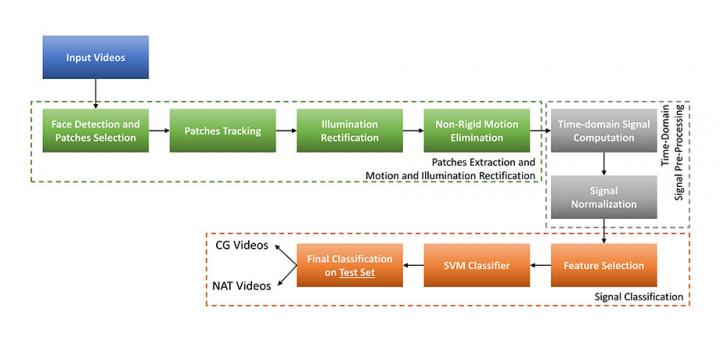[ad_1]

view extra
Credit score: Bonomi and Boato
BELLINGHAM, Washington, USA, and CARDIFF, UK – Current advances in pc graphics are making it attainable to create computer-generated (CG) representations of human beings which are tough to differentiate from their real-world counterparts. “Digital human face detection in video sequences by way of a physiological sign evaluation,” a paper revealed at this time within the Journal of Digital Imaging (JEI), presents a viable, progressive solution to discern between pure people (NAT) and CG faces throughout the context of multimedia forensics, utilizing people’ coronary heart charge because the discriminating characteristic. JEI is co-published by SPIE, the worldwide society for optics and photonics, and by the Society for Imaging Science and Know-how (IS&T).
People current a pulse sign that may be routinely extracted from a video sequence; digital people don’t. Of their paper, Mattia Bonomi and Giulia Boato exhibit that by specializing in an algorithm for pulse-rate estimation from human faces and calculating statistics from that coronary heart charge, they’ll classify the enter face as CG or NAT.
“Current advances in machine studying and pc graphics have led to the fast growth of deep fakes, the place the face of an actual particular person in a video is changed by a pc generated one,” notes JEI Editor-in-Chief Karén Egiazarian. “This expertise is brazenly out there these days, and, along with its large use within the film business and commercials, it has been additionally utilized by fraudsters. However the best way to distinguish a human face from a pc generated one? Bonomi and Boato deal with this query by proposing and making use of a physiological sign evaluation, extracting the guts charge from the video of human face, and utilizing it as a discriminating issue.”
The article authors are Mattia Bonomi and Giulia Boato, each of the College of Trento, Division of Engineering and Pc Science, Trento, Italy.
Karén Egiazarian, a professor of computing sciences at Tampere College, is the editor-in-chief of JEI. The journal is co-published digitally by the Society for Imaging Science and Know-how and by SPIE within the SPIE Digital Library, which comprises greater than 500,000 publications from SPIE journals, proceedings, and books, with roughly 18,000 new analysis papers added annually.
###
About SPIE
SPIE is the worldwide society for optics and photonics, an academic not-for-profit group based in 1955 to advance light-based science, engineering, and expertise. The Society serves greater than 255,000 constituents from 183 nations, providing conferences and their revealed proceedings, persevering with schooling, books, journals, and the SPIE Digital Library. In 2019, SPIE supplied greater than $5 million in group assist together with scholarships and awards, outreach and advocacy applications, journey grants, public coverage, and academic assets. http://www.
In regards to the Society for Imaging Science and Know-how
The Society for Imaging Science and Know-how (IS&T) is a global skilled non-profit devoted to maintaining members and different imaging professionals apprised of the most recent developments within the subject by way of conferences, academic applications, publications, and its web site. IS&T applications embody all elements of the imaging workflow, which strikes from seize (sensors, cameras) by way of imaging processing (picture high quality, coloration, and materialization) to arduous and smooth copy output (printing, shows, picture permanence), and consists of elements associated to human imaginative and prescient, similar to picture high quality and coloration. The Society additionally focuses on a variety of image-related functions, together with safety, digital actuality, machine imaginative and prescient, and knowledge evaluation. http://www.
Contact:
Daneet Steffens
Public Relations Supervisor
daneets@spie.org
+1 360 685 5478
Disclaimer: AAAS and EurekAlert! will not be answerable for the accuracy of reports releases posted to EurekAlert! by contributing establishments or for using any data by way of the EurekAlert system.
[ad_2]









